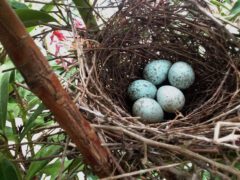Dusky-capped Flycatcher Similar Species Comparison
Main SpeciesDusky-capped Flycatcher
A medium-sized flycatcher with a slim build and a large bill for its size. Breast is gray, belly is pale yellow. Note rusty highlights in wings. In northern parts of range, Dusky-capped shows less rufous in the tail compared to other Myiarchus species.
© Andrew Newmark / Macaulay LibraryCalifornia, December 07, 2020Large-headed flycatcher with erect posture and heavy, straight bill. Compared to other Myiarchus flycatchers, not small size overall, bulky bill, and reduced rusty color in the tail (especially in northern parts of range).
© Daren O'Brien / Macaulay LibraryArizona, July 29, 2017Large-headed flycatcher with a peaky crown and long bill. Often forages within tree foliage, where it can be hard to see.
© Larry Arbanas / Macaulay LibraryArizona, May 01, 2006Large-headed flycatcher with gray breast and yellow belly. Forages at many levels but often remains within tree foliage.
© Blair Dudeck / Macaulay LibraryOaxaca, February 10, 2020Individuals from Central America have darker caps showing more contrast with the back and wings.
© Jan Allen / Macaulay LibrarySan José, January 30, 2020Makes short flights to catch flying insects or pick prey from leaves while hovering. Flights often remain within tree foliage.
© Larry Arbanas / Macaulay LibraryArizona, May 09, 2006Large-headed flycatcher that usually shows contrast between dark crown and browner back (especially in Central and South American individuals). Note the wingbars are less distinct than on other Myiarchus species. Rufous in the tail is more common in the southern parts of the range.
© Georges Duriaux / Macaulay LibraryJinotega, January 19, 2017Slim flycatcher with a large bill, gray breast, and yellow belly. Brownish wingbars can be indistinct. Note rufous highlights in primaries and secondaries. Rufous in the tail is more common in the southern parts of the range.
© Tom Benson / Macaulay LibraryCalifornia, December 13, 2020Note head color is darker than the back; wingbars indistinct and brownish.
© Larry Arbanas / Macaulay LibraryArizona, May 01, 2006Occurs along wooded canyon streams and in pine-oak woodland in the southwestern U.S. and northern Mexico. Also uses many types of tropical forests farther south in range.
© dean anderson / Macaulay LibraryTexas, December 31, 2020Similar SpeciesAsh-throated Flycatcher
Ash-throated Flycatchers are larger than Dusky-capped, with paler yellow on the belly and brighter, whitish wingbars.
© Matthew Pendleton / Macaulay LibraryUtah, June 16, 2015Similar SpeciesBrown-crested Flycatcher
Brown-crested Flycatchers are larger than Dusky-capped, with heavier bills; whiter, more distinct wingbars; and brown crest that is about the same color as the back (Dusky-capped usually has cap darker than the back).
© Scott Holt / Macaulay LibraryTexas, June 01, 2020Compare with Similar Species
Click on an image to compare
Species in This Family
Tyrant Flycatchers(Order: Passeriformes, Family: Tyrannidae)
More to Read
Don't miss a thing! Join our email list
The Cornell Lab will send you updates about birds,
birding, and opportunities to help bird conservation.








































